Sunday 2012-07-22 - Wind!
08:00-12:00 Morning Watch
Wind finally!!! We were setting all canvas!
Light winds, sunny, excellent weather.
I was on the mizzen mast the first time, helping out to unbend the large triangular mizzen sail, sometimes called "the spanker".
As all staysails were set, we saw another marvellous ship coming closer: she had been with us in Brest also ...
The "Staatsraad Lehmkuhl" passing us by under sails =)


... and then she set the pirate flag! And our guns were not loaded ... scary =)
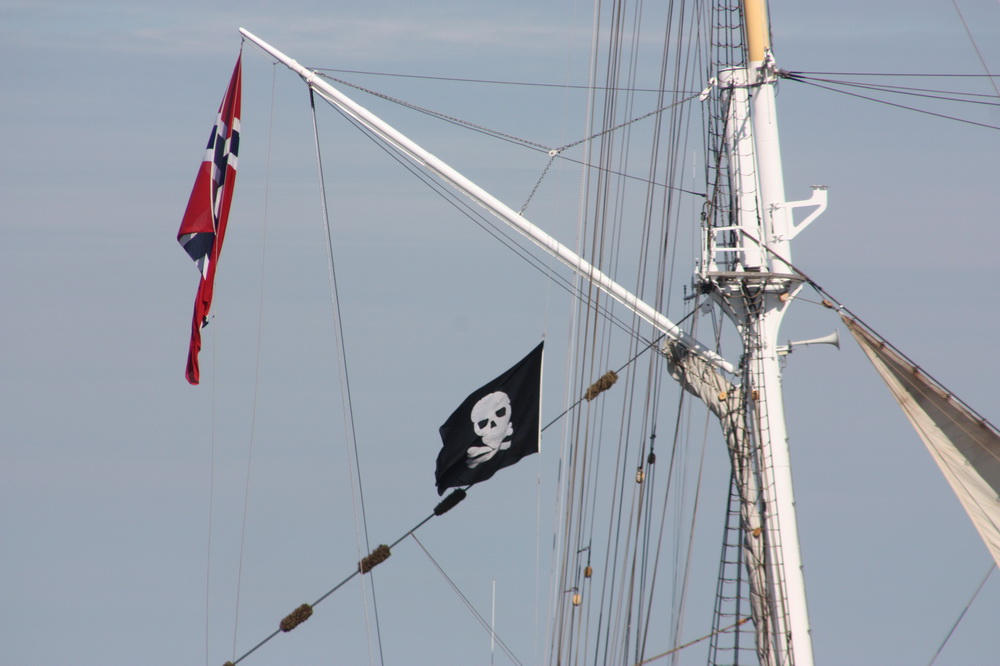
Captain Gunnar Silfverberg Utgaard had his own opinion about her: Staatsraad Lehmkuhl sails for Norway (where he comes from),
but then he said "Den är ju tysk", in Swedish, "but she is German!".
She was built in Germany, that was what he meant (and what I knew; I think he did not know that I in fact was a German, too - but we spoke Swedish
to each other, and obviously my accent is becoming less noticable =). But I kept myself calm, I wanted to hear his words.
He did not like the newer sailing ships,
he preferred the other two Norwegian training ships, Sørlandet and Christian Radich,
in which he had sailed himself. Also he would prefer the old Dar Pomorza over the new Dar Mlodziezy
(from the Mir class). You know, all the ships that were built long before World War II, those were his choice.
I knew pretty well what he meant, and I could agree with him ... nevertheless, I also think that each generation of ships has a beauty of its own,
they have character, wether You like them or not for any reason =)

As the Staatsraad Lehmkuhl was overhauling us, she made preparations to set topsails - we did the same. We sat ALL SAILS!
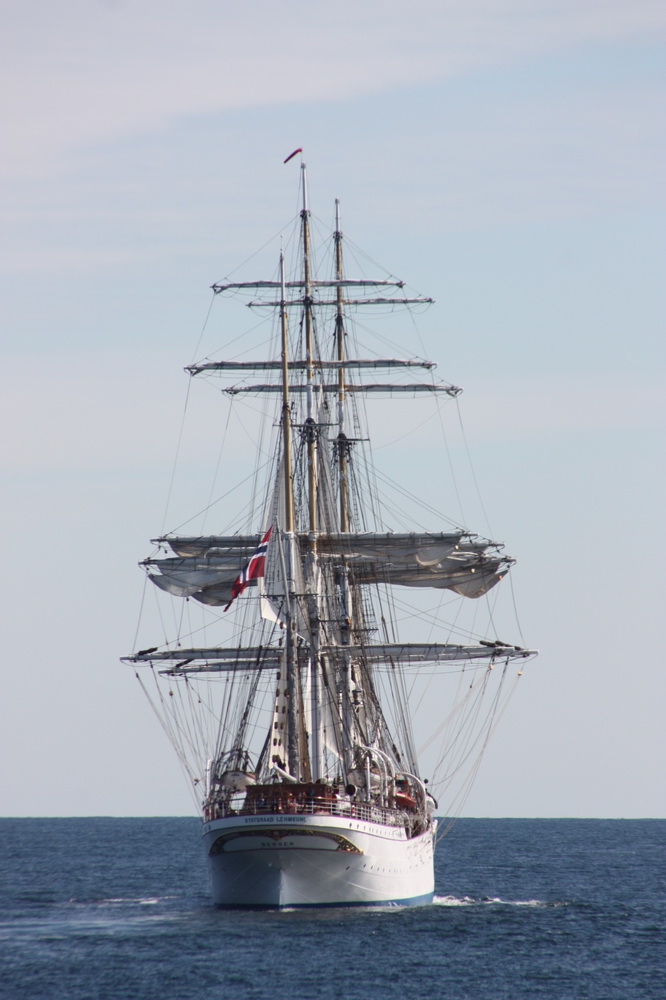
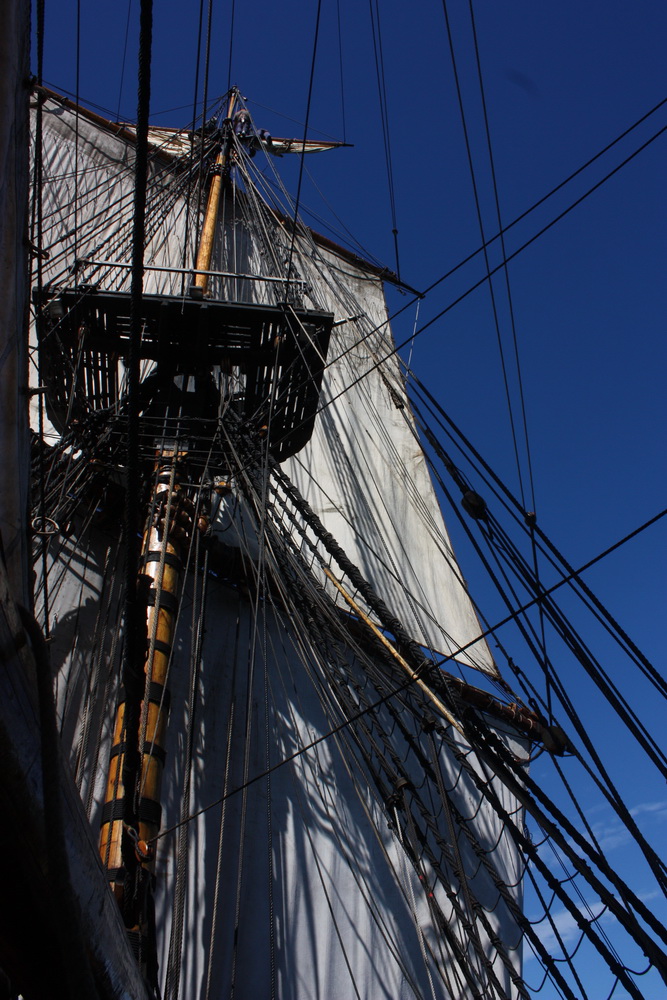
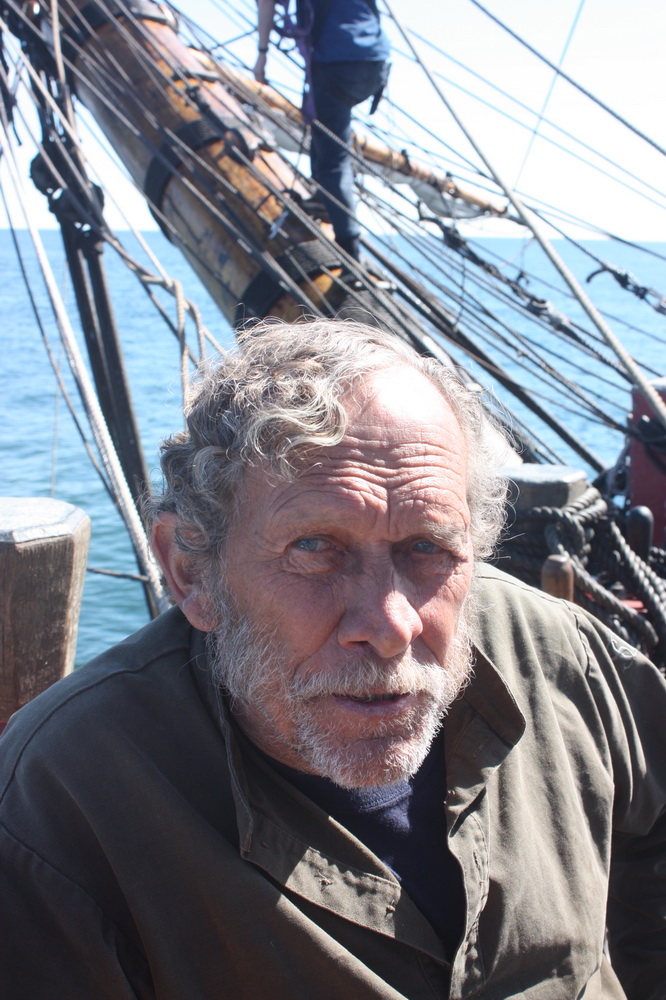
|
Another chance to talk to Philip. He is an icon of a seaman. And for our sailing leg, he was an assisting sailmaker,
which is an irony, because on the first long voyage of the Götheborg to China, Philip was THE sailmaker,
and others were assisting him! He is a walking maritime dictionary, but very calm and friendly.
Now he is 70, and slowly withdrawing himself from the hardest tasks.
Philip has his berth in our quarter, but he is an "idler", another irony because he seems to be constantly busy with sailmaking,
either on the gundeck or on sundeck,
so he is not within our on-duty time scheme of 4h-8h-4h-8h. Idlers are specialists, like Manne the carpenter, or our cooks.
Philip has been at sea all his life, in all kind of ships. When he was younger, he was mostly in steamships,
but later he became more interested into sailing ships and studied them thoroughly. He got interested into sailmaking
and soon he became a master.
Philip knew the Lawhill, a famous four-masted barque that had some unique features in her rigging:
the topmasts were positioned behind her lower masts! And not 100 persons on earth knowing those details today ...
I did. I have a book about the Lawhill in my library, and so we had immediate speak in terms.
Philip also knew the famous Australian maritime author Alan Villiers (1903 - 1982) personally (!), of whom I had read some books! Villiers was one of the
last observers of a dying era of sailing ships between 1910 and 1950, and now I asked Philip: how was the man? What was he like?
He answered, that Alan was a straight man, but very friendly, like an uncle, for all mebers of his crews.
|
And then after a while WE were passing HER by, having all canvas set.
This time, she was on our starboard side:
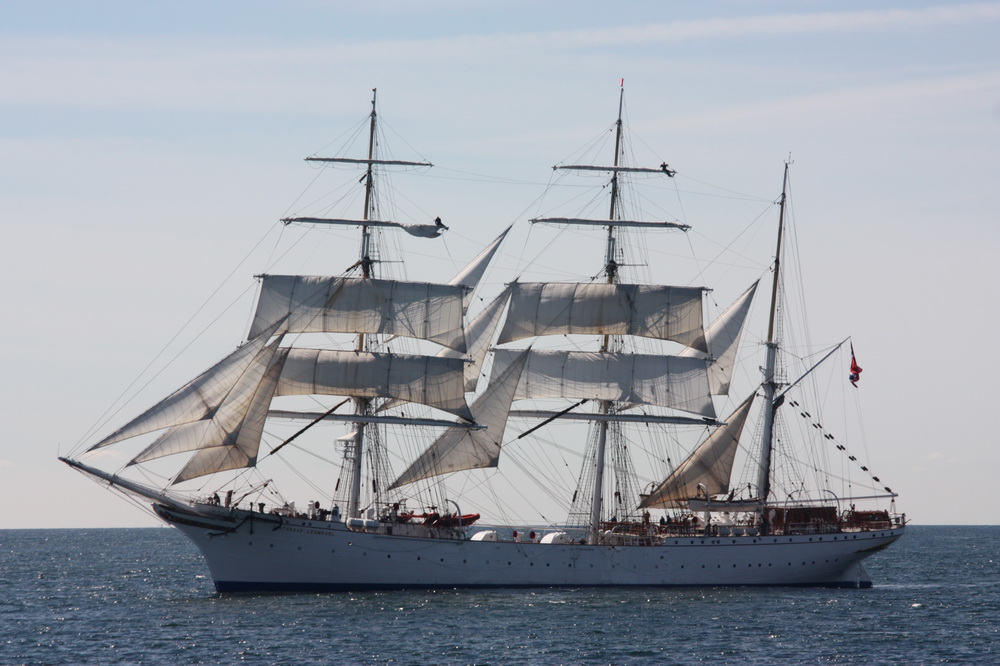
And for the first time, our ship became a cathedral of canvas!
We also set our topgallants, the third yard sails on fore and main mast:
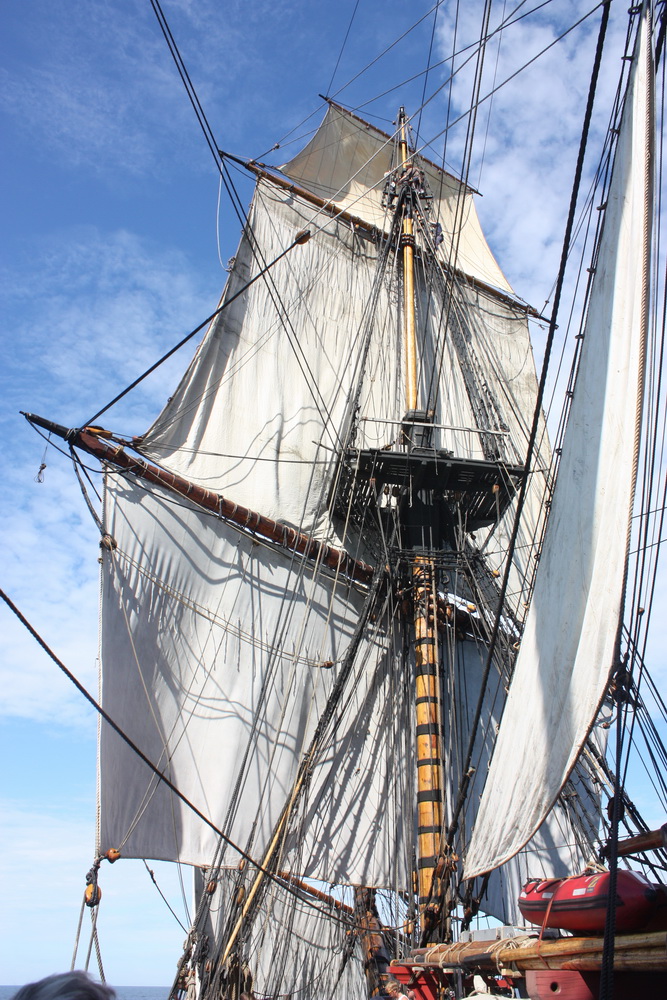
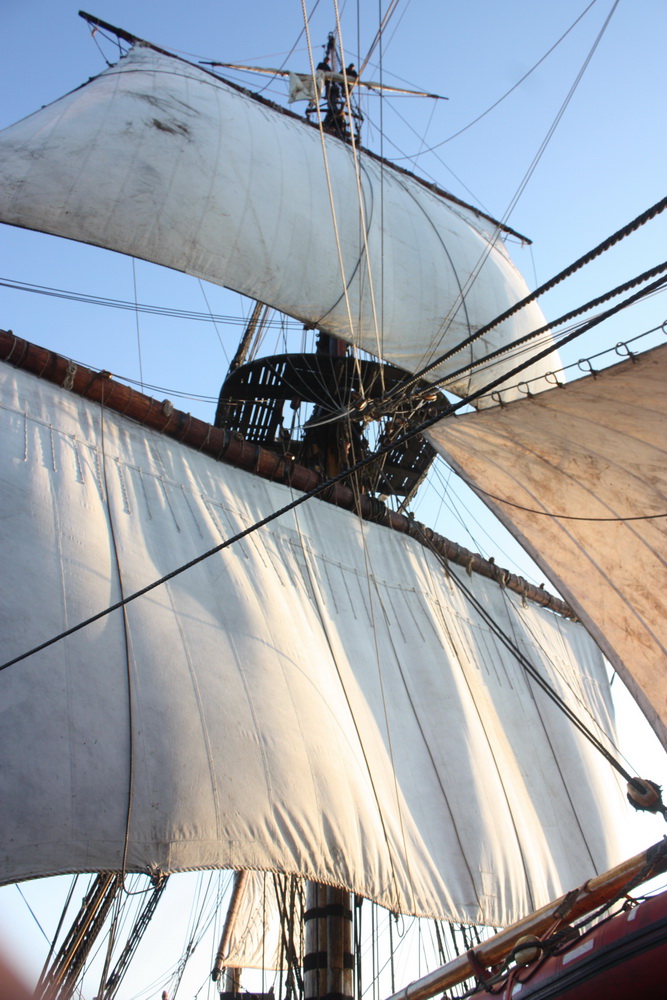
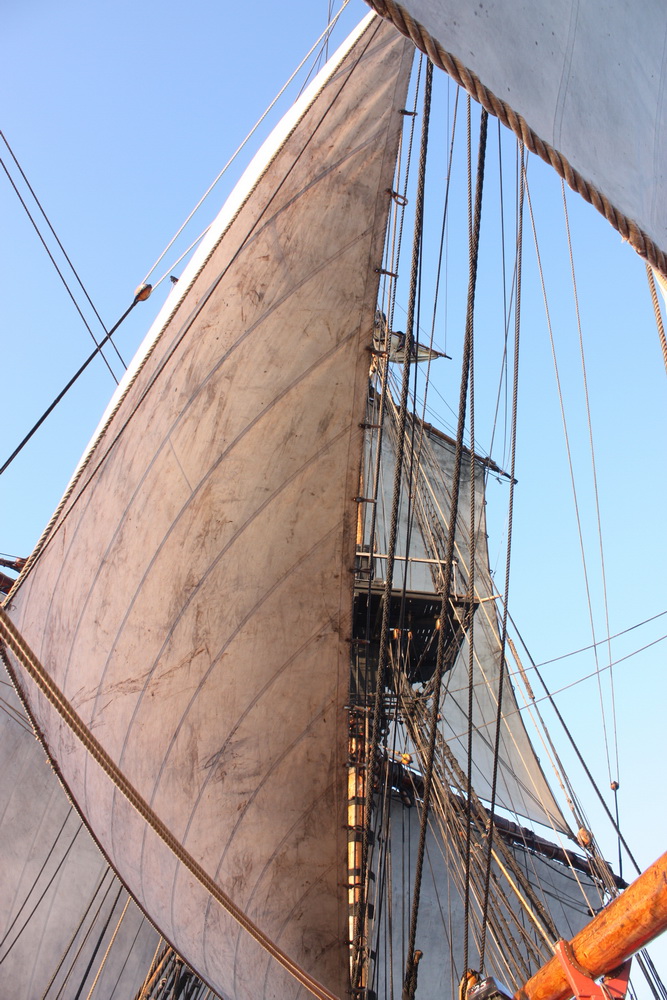
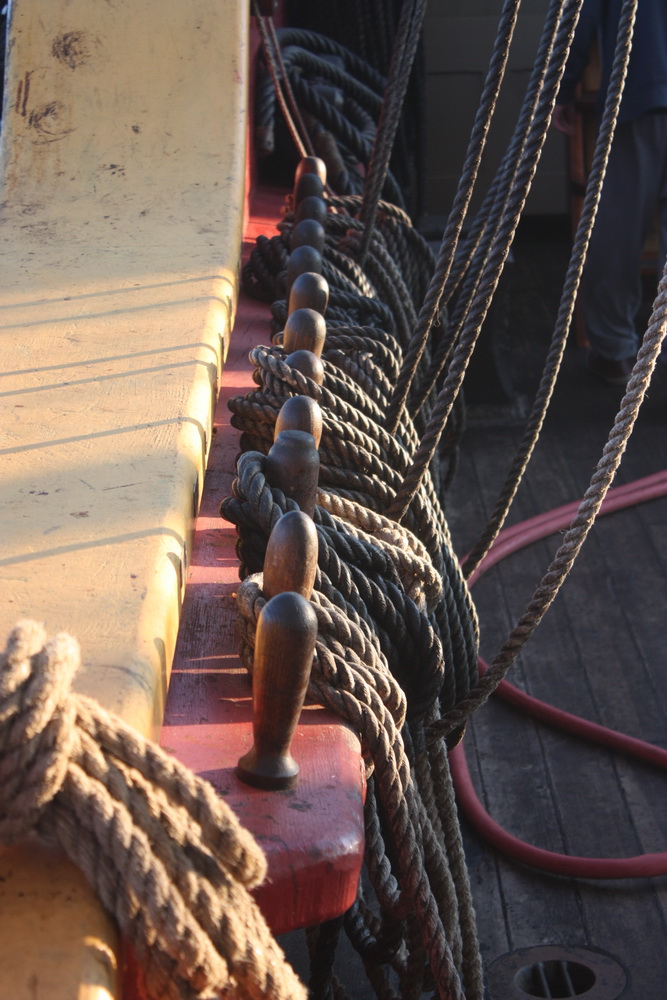
And that is when all their heads mostly watch UP!
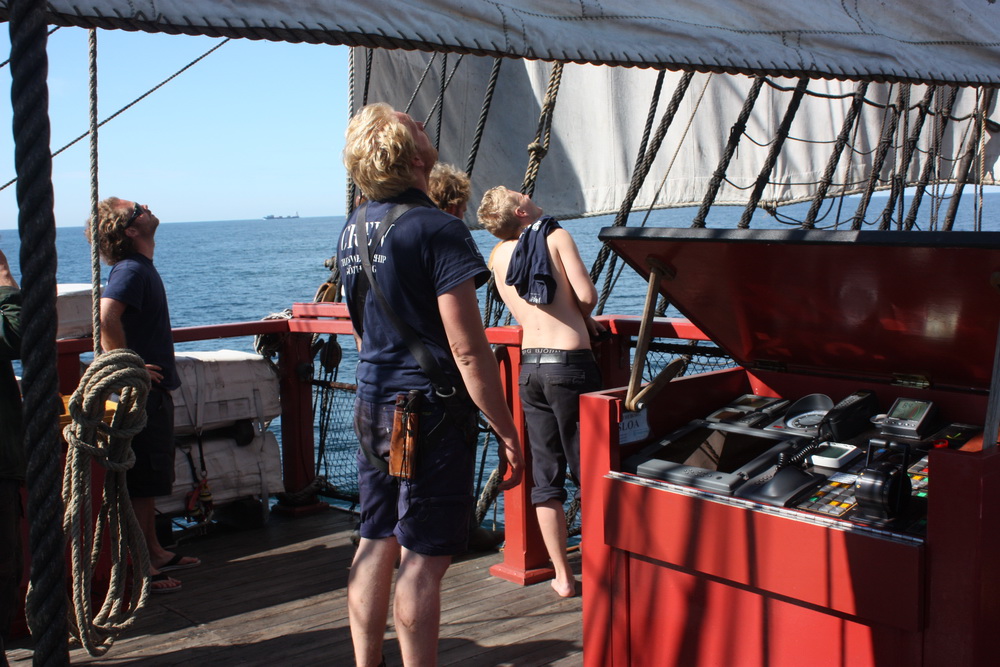
One of the exciting thins of the 8-12 watch is, that You are free on afternoons =)
Some were playing games ...
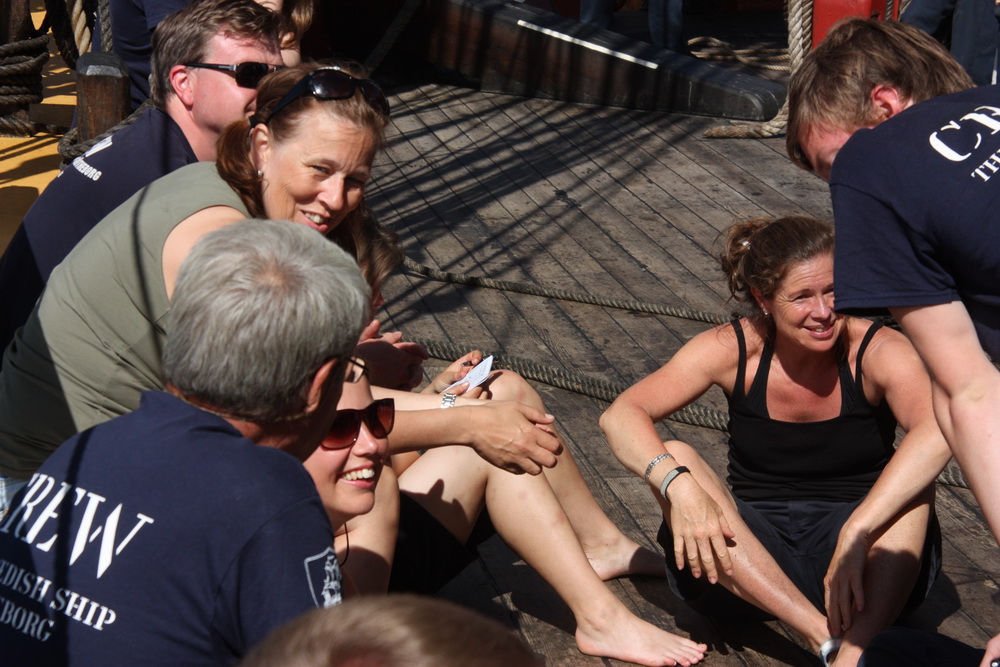
... and some made music. Johann and Erik, two brothers from Sweden, sang a lyric piece of Swedish shanties: "Nordsjön" - North Sea
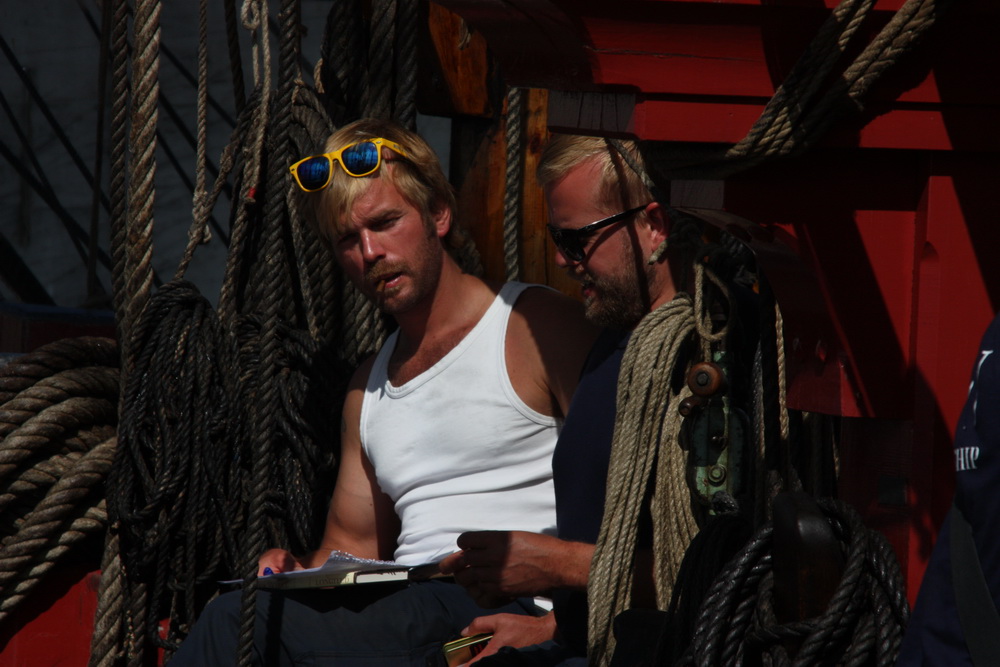
Nordsjön
(Harry Brandelius)
Swedish / Svenska
Gamla Nordsjön som svallar och brusar
under vindarnas växlande gång,
sedan urminnes tider oss tjusar
din betagande rytmiska sång
och jag känner hur skeppsdäcket svajar
vid din böljas förtrollande smek,
medan stimmet av tumlare ilar
fram med vårt fartyg i glittrande lek.
På ditt blånande fält vill jag dröja,
ty du är mig kär, vart det bär.
Alla världens nationer dig plöja
följande din led mellan fjärran och när.
ur ditt djup hämtar fiskar´n sin äring
du välvande nyckfulla hav
lika väl du ger sjöfolk dess näring,
så kan du bädda bland tången dess grav.
Men det är skönt när man får lätta ankar
och sticka ut på böljornade blå.
När vi passera Doggers bankar,
från fiskeflottan en hälsning vi få.
Varhelst en svensk sjöman på jorden vankar
har han Nordsjön i blodet ändå
därför hälsar han glatt med ett kraftigt: Hurra!
den gungande Nordsjön blå.
På din vidsträckta, blånande bölja
ifrån Dover till Pentland i nord,
kan sedan tidernas morgon jag följa
många färder runt hela vår jord.
Där ett drakskepp för länsande vindar
går med degel så vita som snö
här Spaniens stolta armada fram
på sin kurs emot britternas ö
och den holländska smäckra kravellen
gungar glad ihåg på din våg
och fregatten med höga kastellen
seglar fram med spelande tackel och tåg
och för fullt i var klut kan draga
flyr klippern på vågornas dans.
Där är sjölivets vackraste saga,
den tid då ångbåten ännu ej fanns.
Men det är skönt när man får lätta ankar
och sticka ut på böljorna de blå.
När vi passera Doggers bankar,
från fiskeflottan en hälsning vi få.
Varhelst en svensk sjöman på jorden vankar
har han Nordsjön i blodet ändå
därför hälsar han glatt med ett kraftigt: Hurra!
den gungande Nordsjön blå.
Ur Wikipedia:
Nordsjön, även kallad Gamla Nordsjön, är en svensk sång i valstakt med sjömansmotiv. Text och musik skrevs av Martin Nilsson. Sången beställdes av Kooperativa förbundet, KF, och sjöngs år 1931 in av John Wilhelm Hagberg, under pseudonymen Wilhelm Arne. Sången hette då Sommarsegling.
Nordsjön fanns med i KF:s reklamfilm Vi far till London, som spelades in 1935. Då hade texten skrivits om med ett Nordsjö-tema. Sången förknippas ofta med artisten Harry Brandelius, som spelade in Nordsjön den 16 oktober 1944. Andra artister som har spelat in Nordsjön är Fred åkerström (på skivan Sjöfolk och landkrabbor, 1978), vissångaren Stefan Ljungqvist (Kustens pärlor, 2000) och dragspelaren Calle Jularbo.
|
North Sea
(Harry Brandelius)
My humble English translation ... but I am no song writer =)
Thou Old North Sea that waves and blusters
Under the changing winds
Ever since Thou make us love
Thy breathtaking rythmic song
And I feel how the deck is waving
By the charming touch of Thy waves
While the tumblers voices come
Along with our ship in a gliding play
Upon Thy blue fields, I will dwell
As Thou are my Love, whereever it goes.
All the worlds nations sail upon Thee
following Thy ways to near and far
From Thy deep, the fishers make their fortune
Thou vaulting, moody Sea
Likewise You feed all the people,
Or take them with Thee as their grave.
But it is good to weigh the anchor
And to go to sea on the waves blue
When we pass the Dogger Banks,
We get a hail from the fishery fleet
Whereever a Swedish sailor may go in this world
He has still the North Sea in his blood
So he hails with a sound: Hurra!
The Waving North Sea Blue
On Thy long moving waves
From Dover to Pentland in the north,
I can follow since ancient times
Many fearings around the world.
Where a Dragon ship catches the winds
It goes out with a Sail white like snow.
Here came the proud Spanish Armada
On its course to the British Ilses
And the Dutch slim Caravels
Gliding smooth through Thy Waves
And the frigates with their high castles
Sail away with tackles and ropes
And for all our canvas the can drag,
Flies the clipper, dancing on the waves.
That is the saga of the old sailors life,
When the steamers were yet to come.
But it is good to weigh the anchor
And to go to sea on the waves blue
When we pass the Dogger Banks,
We get a hail from the fishery fleet
Whereever a Swedish sailor may go in this world
He has still the North Sea in his blood
So he hails with a sound: Hurra!
The Waving North Sea Blue
From Wikipedia:
Nordsjön, also called Gamla Nordsjön, is a Swedish valse song with a sailors motive. Text and music was written by Martin Nilsson. The song
was ordered by Kooperativa förbundet, KF, and was first recorded in 1931 by John Wilhelm Hagberg, under the artist name Wilhelm Arne.
The song was named Sommarsegling then.
Nordsjön was a feature in KF:s commercial film Vi far till London (we go to London), that was made in 1935.
The text was altered then to a North Sea theme.
The song is often remembered as it was sung by Harry Brandelius, who recorded Nordsjön Oktober 16 1944.
Other artists also recorded Nordsjön: Fred åkerström (på skivan Sjöfolk och landkrabbor, 1978), Stefan Ljungqvist (Kustens pärlor, 2000) and the accordionist Calle Jularbo.
|
What I found most astonishing was, that such an old song is still known and sung today!
20:00-24:00 Evening Watch
Oh, I am on BURR again? Well, OK, I take any task ... and any freedom using my camera =)
After being Brandråd (fire watcher) first, Dag already awaited me on a nice "seat" on the bowsprit - he was lookout the last hour
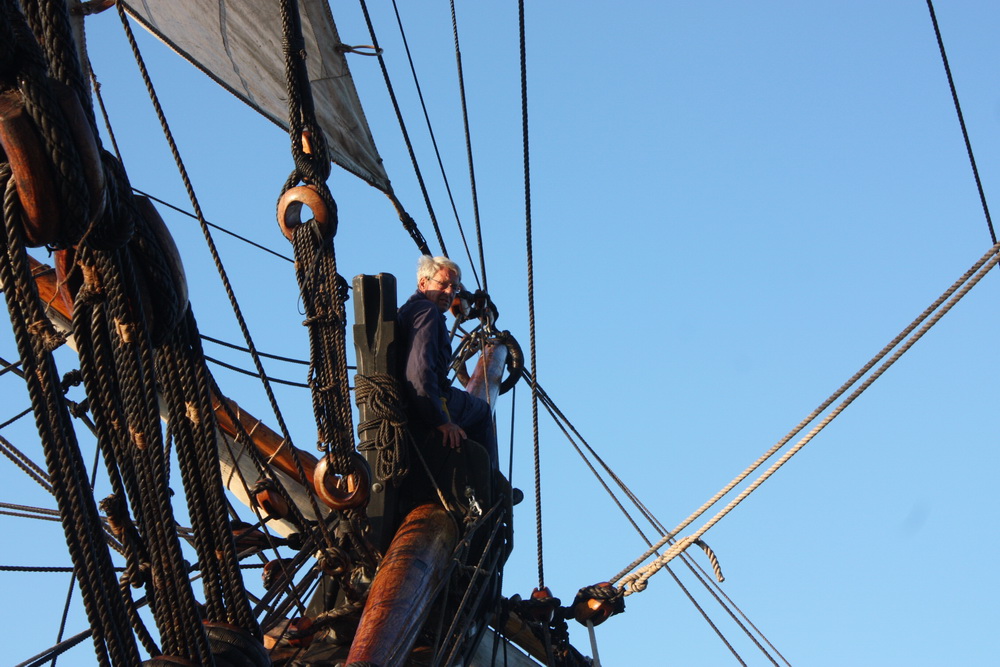
And that was now my place for the next hour. There was no traffic at all to report - what a peaceful summer evening this was!
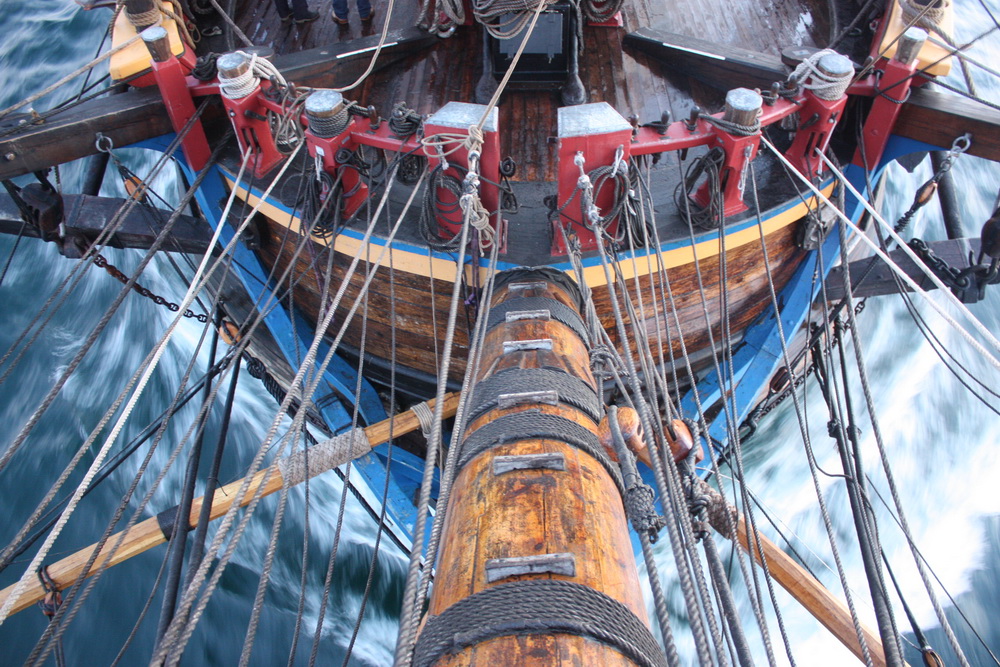
I LOVE THIS PLACE !!!
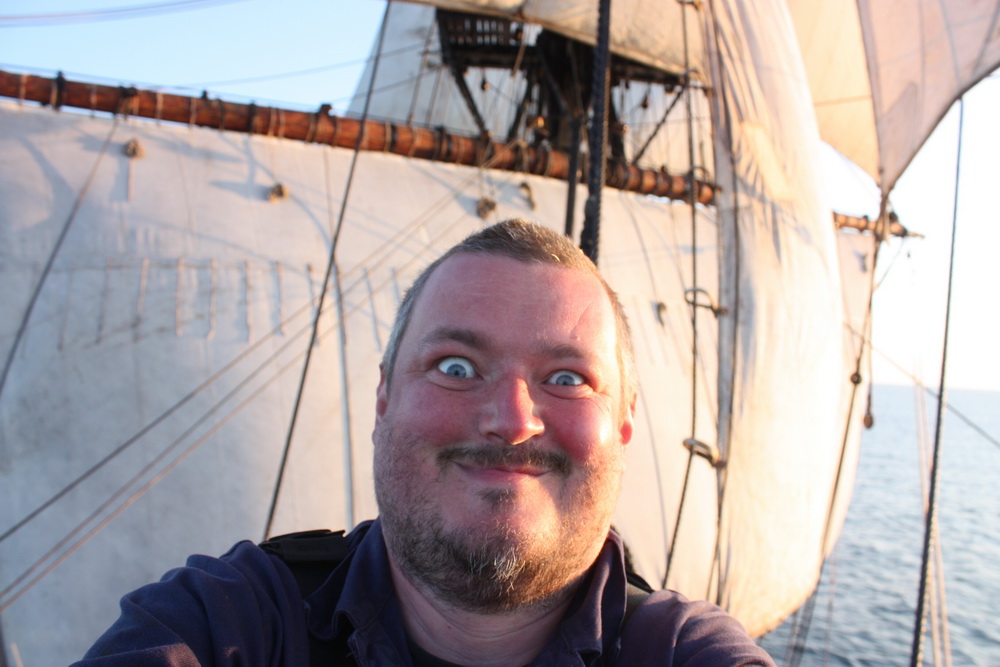
And NOW she got me, no way to escape from here - XD. Sara, our professional photographer, came up to make her pictures.
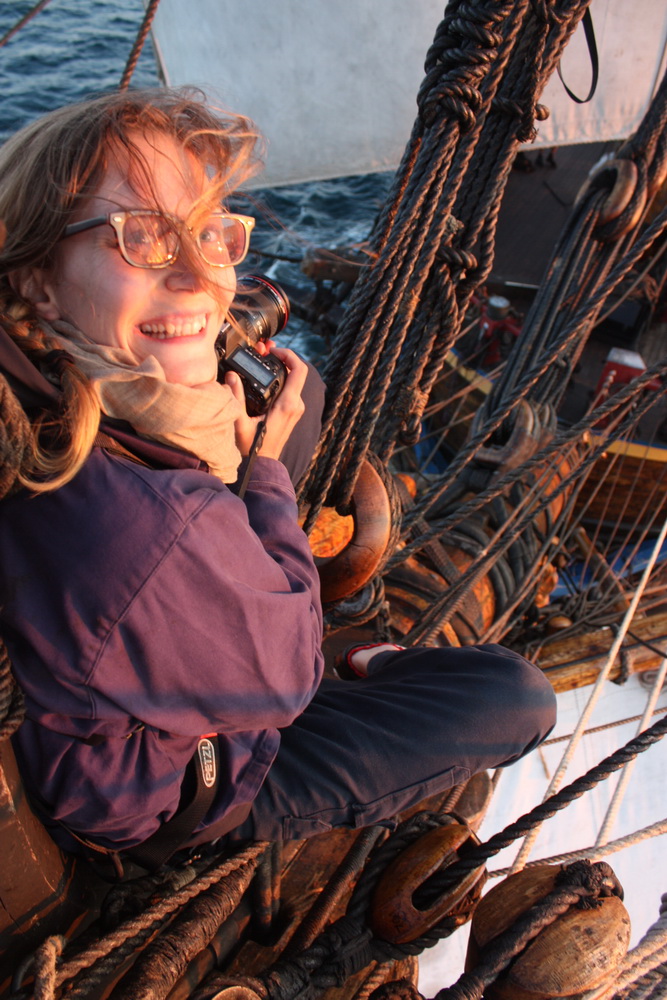
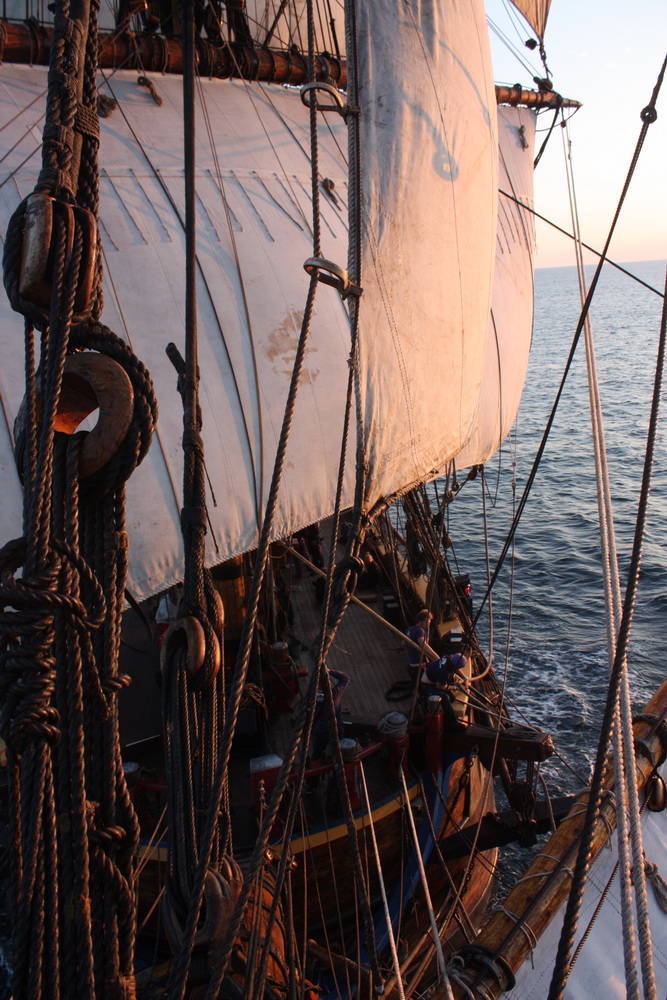
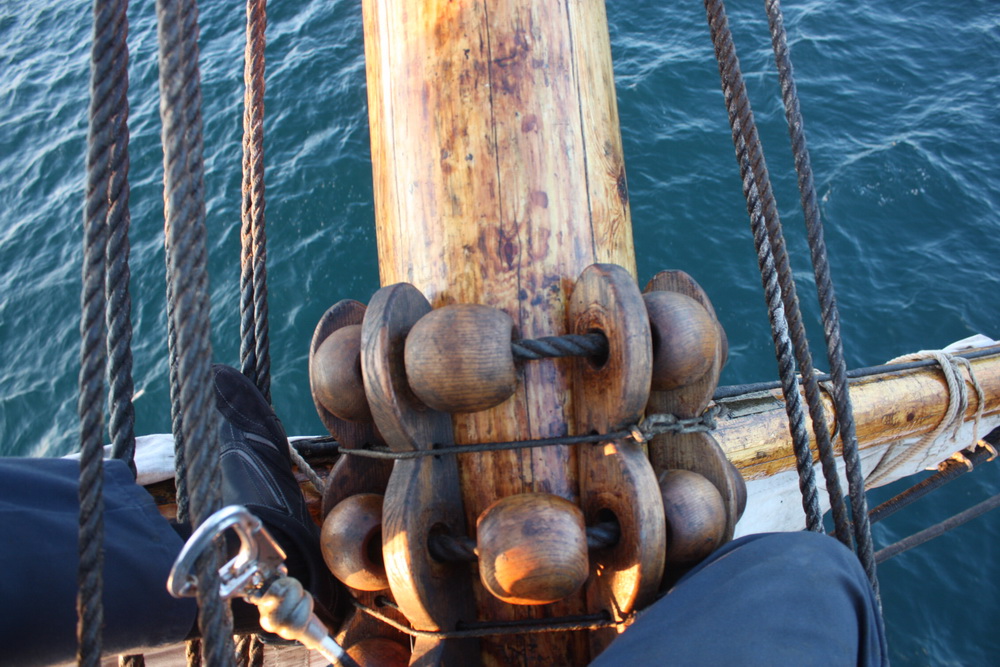

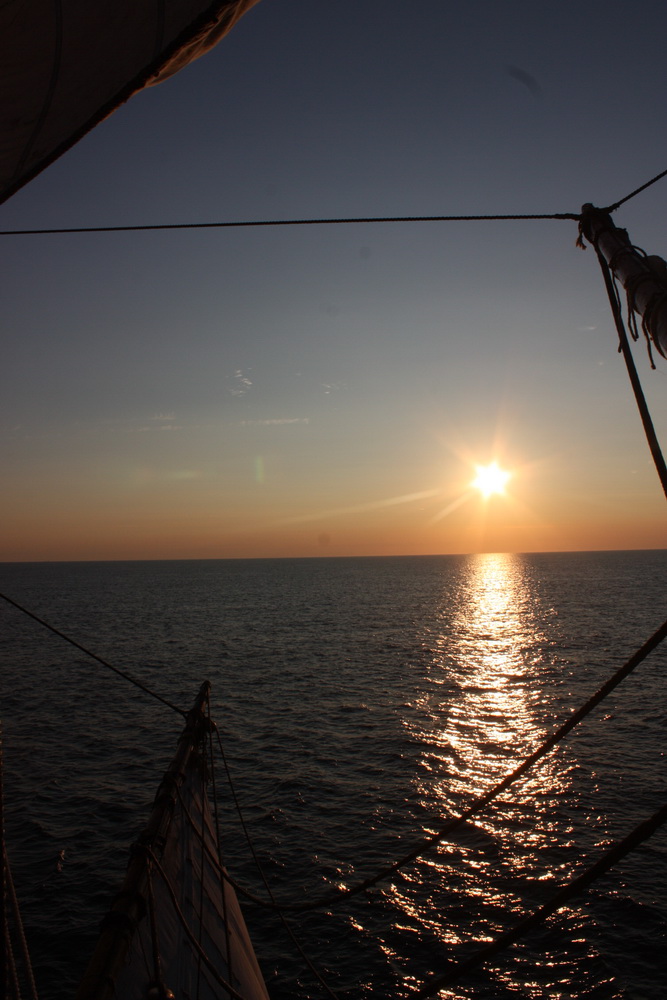
22:00 PM - time to be helmsman 2 and 1 (in that order). Another deckhand would be look-out then.
Helmsmen can also be helmswomen, of course. Everybody onboard does everything =)
Helmsman 2 is just supporting helmsman 1 who gives orders how to move the helm.
And helmsman 1 gets his orders from the nav officer, we had two, who where both very focussed
to keep everything under control; after all, we were all landlubbers steering a fifty-meter vessel
by HAND!
So it is one of the most responsible jobs to hold course, otherwise the ship gets into REAL trouble!
And it is not easy to hold course. Especially the tidal waves in the North Sea procude tidal currents
which are almost uncalculable under the various sea grounds, even if it has been sounded over and over
and noted in the charts. The ship "swings" aroung plus minus 5 or even 10 degrees away from the course,
and the helmsmen need to steer against it, but as smoothly as possible. Hard steerings are only
done in a port or under command of a pilot.
While the sea gets darker in the evening, the helmsmen see virtually nothing but the helm and the instruments,
indicating the true course (using an inertial compass, which is mandatory standard for all ships and even airplanes today).
And when it is getting late, the helmsmen need to fight tiredness, as they stand at the helm for at least one hour,
almost not moving, but focussing on the course. It is a little like PC work, it looks so easy, but it isn´t, by far.
The BURR posts are only for four people, two others help in the galley, but the rest of the watch has all kinds of tasks
and excercises on deck and in the rigging. For example, the topgallants are taken in for the night, four people go aloft
to bend that sail. We have topgallants on the fore and the main mast.
And on 24 hours PM, midnight, when the new watch takes over, we see the stars above our rigging, before we go to sleep!
Questions? Feel free:
j_gelbrich@gmx.net
|